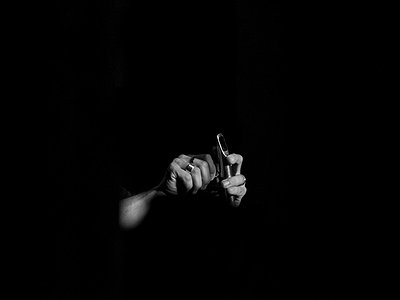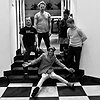Name: Mats Gustafsson
Nationality: Swedish
Occupation: Saxophonist, Improviser, Composer
Current Release: Svårmod Och Vemod Är Värdesinnen with The End on RareNoise
Recommendations: Only one???? When you ask that question to a discaholic … ha ha …. things might go wrong. I am a collector… and it is just impossible for me to point only one piece out .… it all depends on the day when the question is asked.
Today you get one answer – tomorrow a different one.
But … the last GREAT book I have read is Paul Auster´s Moon Palace. The last GREAT record I listened to is Tony Fruschella´s self titled album on Atlantic Records. The last great painting I looked at is the cover of the debut album of the THE END: on RareNoiseRecords: an icon made my very dear friend Edward Jarvis inspired by a poem by the great Swedish poet Harry Martinsson. Tomorrow I will look, hear, smell, sense and taste something entirely different.
Website / Contact: If you enjoyed this interview with Mats Gustafsson, visit his homepage or facebook account for more in-depth biographical information, current tour dates and personal insights.
When did you start playing your instrument, and what or who were your early passions or influences? What is it about music and/or sound that drew you to it?
I started to play the saxophone after hearing Sonny Rollins playing the horn in my hometown Umeå, when I was 14 years old. I never had a sax teacher – but tried to figure it all out on my own. A bad and equally good decision. DIY from the beginning. I was already drawn to free jazz and experimental music, playing distorted electric piano in some local punk groups and also with a local band playing music inspired by King Crimson and Mahavishnu Orchestra. It was all about research from the beginning.
And it was all about energy … raw, pure energy. and in many ways – it still is. Energy that you can touch and feel. Inner and outer.
My first and only hero is still Little Richard.
For most artists, originality is first preceded by a phase of learning and, often, emulating others. What was this like for you? How would you describe your own development as an artist and the transition towards your own voice? What is the relationship between copying, learning and your own creativity?
This is all key. And it's important that we continue to learn. That we WANT to learn more. To find out about things. There is no end to that. And there should not be. We will never be done with it. When you understand that all knowledge comes from others, you just need to transform it into your own world, art and music … then things really start to open up. When you deeply understand that mistakes are the best tools ever for getting and finding your own personal language. There is no way to go around that fact. Mistakes are still my best friends! I went a different road, compared to most of my colleagues, no music academy, conservatories and stuff. I was just lucky to be able to start touring internationally early on. And learning it all on the road. And off road, ha ha! On stage and off stage, with the help of some amazing sources of inspiration and information. One of the most important sources for me was listening to and collecting vinyl records, and the way that my mentor Harald Hult was feeding me with in information and wisdom. It is all in the grooves. And yes, Evan Parker was always right: “the roots are in my record player”.
To build your own language is an amazing journey to take. To build it up, to learn, to make the research. It never ends. ALL tools are good – as long as you make the knowledge yours. To copy is just a tool among others. We are free to use ANY elements from ANY source available and transform it. In some cases, you need to go really deep into certain music and languages. To really understand. All knowledge is good.
That is beautiful.
What were some of your main artistic challenges when starting out as an artist and in which way have they changed over the years?
It has always been about the challenge and the research. The re search. The search.
And it will always be. The biggest challenge is to find your own personal voice on your instrument … and to keep developing it, all the time. ALL the time!
In the very beginning the hardest thing was – fore sure – to find people to play with. When you grow up in a smaller town, there are not so many alternatives. But I was lucky to be involved in creative processes with some amazing people early on. The connection with the art scene has always been crucial. We made many experiments with performance art and music really early in my hometown Umeå. With the visual artist Edward Jarvis and my friend and colleague Kjell Nordeson on drums and percussions. I was blessed to have those persons around me – we could initiate many projects together and find out about small and larger pictures and mechanisms together.
The search never ends.
Anything that challenges you should be checked out.
Anything that kicks your mind and butt needs to be checked out.
Tell me about your instrument, please. How would you describe the relationship with it? What are its most important qualities and how do they influence the musical results – and possibly even your own performance?
Well, I play many different kinds of saxophones and I do have a special relation to all of them. I use primarily the bari sax and the tenor sax. Those are my main axes. But I need – of necessity - to work on my soprano and bass sax as well. The different horns create different solutions musically … they put me in different contexts. I love my horns. And I love practising. I wish there were more hours of the day to be able to practise more and find new sounds and techniques on my horns.
The addition of using live electronics has been very essential to me. It has affected the way I play my horns a lot. And the sax playing has fed how I use the electronics. Since friction and resistance are two of the most important parameters for me, I try to push myself by playing the “wrong” horn in certain situations. It can be very rewarding to play soprano sax in a situation that calls for a bari sax and vice versa.
But you need to question it all … all the time. And look for new challenges all the time.
There is a LOT to do. To make it happen. I can´t wait for the next moment of playing my horns and make some more noise.
Derek Bailey defined improvising as the search for material which is endlessly transformable. Regardless of whether or not you agree with his perspective, what kind of materials have turned to be particularly transformable and stimulating for you?
All materials are useful. It is simply just the way you use them that means something. You have to make the sounds yours to begin with. And then transform those sounds into music, by interaction and communications. As simple as that.
All sounds are transformable.
As a sax player I have always found percussive sounds to be the most useful and inspirational ones. It is really endless what you can do with percussive sounds and techniques. If you add alternative breathing techniques and alternative fingering settings to the picture … you have quite something to work on for some years.
But it is all about attitude. And the willingness to listen. To try. And to dare to make mistakes. And to use the mistakes to your advantage. To use my mistakes has always been my strategy and goal. To find and formulate the questions. Not necessarily to find the right and correct answers, but to find the interesting and stimulating questions.
Derek was always right. Yes… “music is like living, but better”!
How is playing live in front of an audience and in the studio connected? What do you achieve and draw from each experience personally? How do you see the relationship between improvisation and composition in this regard?
To play live is about an exchange. An exchange of the instant now and the specifics of the room – and its content and its specific acoustics - you work in. Between the performer and the audience. A sharing that is unique and only happens once. And then it is gone.
To play in a studio, whether solo or with a group, is something entirely different. I love both. I need both. The audience can kick you in certain directions, that can be of a great surprise for yourself and for the audience as well.
The studio creates a focus on a different level. This appeals to me.
I'm learning a lot from the two different situations. I'm not so keen on making live recordings any longer …. I like the process of being in a studio and really use it as a studio. When it comes to capturing the colours of the instrument, the closeness to the mic (and how to use the mic as a playing partner almost) and the acoustic environment.
Live is live and should not necessarily be captured. It is in the air for a while. And then it is gone.
I like that.



